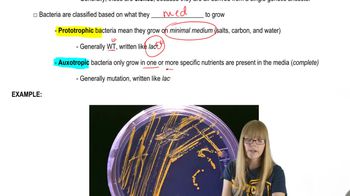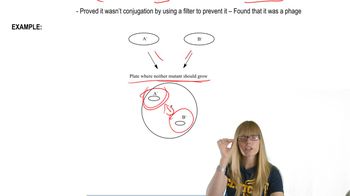A cotransduction experiment was performed with two bacteria strains. The first train has the genotype l+ g m+ while the second strain has the genotype of l g+ m. The researchers found that 46 colonies had cotransduced m+ with l+, while only 25 colonies had cotransduced g with l+. Using this information determine which of the following gene pairs are closest together.
Table of contents
- 1. Introduction to Genetics51m
- 2. Mendel's Laws of Inheritance3h 37m
- 3. Extensions to Mendelian Inheritance2h 41m
- 4. Genetic Mapping and Linkage2h 28m
- 5. Genetics of Bacteria and Viruses1h 21m
- 6. Chromosomal Variation1h 48m
- 7. DNA and Chromosome Structure56m
- 8. DNA Replication1h 10m
- 9. Mitosis and Meiosis1h 34m
- 10. Transcription1h 0m
- 11. Translation58m
- 12. Gene Regulation in Prokaryotes1h 19m
- 13. Gene Regulation in Eukaryotes44m
- 14. Genetic Control of Development44m
- 15. Genomes and Genomics1h 50m
- 16. Transposable Elements47m
- 17. Mutation, Repair, and Recombination1h 6m
- 18. Molecular Genetic Tools19m
- 19. Cancer Genetics29m
- 20. Quantitative Genetics1h 26m
- 21. Population Genetics50m
- 22. Evolutionary Genetics29m
5. Genetics of Bacteria and Viruses
Transduction
Problem 20a
Textbook Question
A triple-auxotrophic strain of E. coli having the genotype phe⁻ met⁻ ara⁻ is used as a recipient strain in a transduction experiment. The strain is unable to synthesize its own phenylalanine or methionine, and it carries a mutation that leaves it unable to utilize the sugar arabinose for growth. The recipient is crossed to a prototrophic strain with the genotype phe⁺ met⁺ ara⁺. The table below shows the selected marker and gives cotransduction frequencies for the unselected markers.

Identify the compounds present in each of the selective media.
 Verified step by step guidance
Verified step by step guidance1
Step 1: Understand the problem. The goal is to identify the compounds present in each selective media based on the genotype of the recipient strain (phe⁻ met⁻ ara⁻) and the donor strain (phe⁺ met⁺ ara⁺), as well as the cotransduction frequencies provided in the table.
Step 2: Recall the concept of selective media. Selective media are designed to allow the growth of organisms with specific genotypes while inhibiting others. For example, if a media lacks phenylalanine, only strains that can synthesize phenylalanine (phe⁺) will grow.
Step 3: Analyze the table. The table provides cotransduction frequencies for unselected markers when a specific marker is selected. For example, when phe⁺ is selected, 2% of colonies contain met⁺ and 51% contain ara⁺. This information helps determine which markers are linked and which compounds are required for growth.
Step 4: Determine the compounds in the selective media for each marker. For phe⁺ selection, the media likely lacks phenylalanine, forcing only phe⁺ strains to grow. For met⁺ selection, the media likely lacks methionine, allowing only met⁺ strains to grow. For ara⁺ selection, the media likely contains arabinose as the sole sugar source, allowing only ara⁺ strains to utilize it for growth.
Step 5: Use the cotransduction frequencies to infer genetic linkage. Higher cotransduction frequencies indicate closer genetic linkage between markers. For example, the high cotransduction frequency (79%) between met⁺ and phe⁺ suggests these genes are closely linked, which can help interpret the results of the experiment and the compounds required in the media.
 Verified video answer for a similar problem:
Verified video answer for a similar problem:This video solution was recommended by our tutors as helpful for the problem above
Video duration:
1mPlay a video:
Was this helpful?
Key Concepts
Here are the essential concepts you must grasp in order to answer the question correctly.
Auxotrophy and Prototrophy
Auxotrophy refers to the inability of an organism to synthesize a particular compound required for its growth, necessitating supplementation from the environment. In contrast, prototrophic organisms can synthesize all necessary compounds from basic nutrients. In this experiment, the E. coli strain is auxotrophic for phenylalanine (phe⁻) and methionine (met⁻), while the prototrophic strain can grow without additional supplements.
Recommended video:
Guided course

Bacteria in the Laboratory
Transduction
Transduction is a process of horizontal gene transfer in bacteria, where bacteriophages (viruses that infect bacteria) transfer genetic material from one bacterium to another. This method can introduce new traits, such as the ability to synthesize certain compounds, into the recipient strain. Understanding transduction is crucial for interpreting the genetic changes observed in the E. coli strains during the experiment.
Recommended video:
Guided course

Transduction
Cotransduction Frequencies
Cotransduction frequencies indicate the likelihood that two genetic markers are transferred together during transduction. High cotransduction frequencies suggest that the markers are located close to each other on the bacterial chromosome, while low frequencies imply they are farther apart. Analyzing these frequencies helps determine the genetic linkage and the effectiveness of the transduction process in the experiment.
Recommended video:
Guided course

Transduction
Related Videos
Related Practice
Multiple Choice
458
views
2
rank


